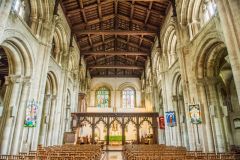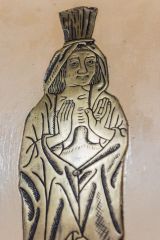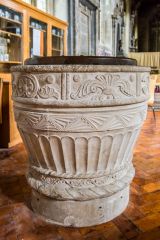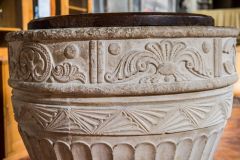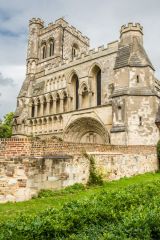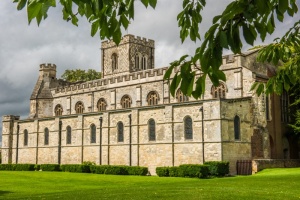
In 1131 Henry I established an Augustinian priory at Dunstable. It was at Dunstable Priory that the annulment of Katherine of Aragon's marriage to Henry VIII was announced in 1533. The Augustinians were evicted shortly after in the Dissolution of the Monasteries, but parts of the priory church of St. Peter have survived as the parish church.
History
Henry I re-founded the town of Dunstable in the early 12th century. In 1131 the king tried to promote his new town by establishing an Augustinian Priory. It took over 100 years to complete the Priory buildings, and the Priory church was not consecrated until 1213.
Despite its royal connections, the Priory was frequently short of funds. Matters were made more difficult for the canons when a Dominican Friary was founded on the opposite side of High Street in 1259. The two monasteries vied with each other for the favour of wealthy patrons.
Until the late 14th century the townsfolk of Dunstable worshipped in the north aisle. As the town grew the congregation began to disrupt the canon's own worship. In 1392 the canons gave the entire west end of the church to the townsfolk of Dunstable on condition that they keep it in good repair.
That fact helped preserve part of the church after the Priory was dissolved at the Reformation. The east end of the Priory church was pulled down, along with all the monastic buildings, leaving the nave to become the parish church.
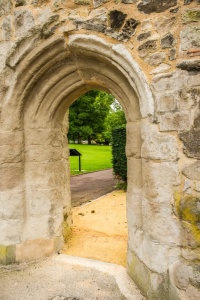
medieval gatehouse
A Medieval Crime
The Priory is such a peaceful place today, surrounded by quiet parkland, but things were not always so peaceful. In 1276 violence broke out when a group of Edward I's royal falconers were staying in the Priory. According to an account in the Priory annals for 16 December 1276, the falconers had an argument with the chaplain and some of the canons.
The falconers must have been a rowdy bunch, for it is recorded that they late went out into the streets of Dunstable and there fatally wounded the chaplain. When they tried to re-enter the Priory the gatekeeper refused to let them in. The falconers beat up the gatekeeper and rampaged through the Priory, causing further injuries to several of the canons.
The canons raised an alarm by ringing the bells and the townsfolk ran to intervene. Even with the help of the townsfolk, the Prior had a great deal of trouble stopping the fighting.
The next day the falconers took their case to the king. They complained about their treatment and accused the Prior of serious misdemeanours. The king sent the complaint to the local justice. He must have expected the justice to side with his falconers but things did not turn out according to his plan. A dozen witnesses swore that the Prior, canons, and townsfolk were innocent, and the verdict was given in their favour.
The king refused to accept the verdict and came in person to Dunstable. His presence had no effect; three dozen men from outside Dunstable declared in his presence that the Prior and canons had no case to answer and that whoever of the king's household was responsible for killing the chaplain should be punished.
The records do not show whether any punishment was forthcoming.
St. Peter has been called one of the finest examples of Norman ecclesiastical architecture in England. The west front is magnificent, with a huge entry consisting of four arches (1170) above a later 15th-century doorway.
The entry is highly decorated, with diaper pattern and stiff-leaf moulding providing relief for a profusion of small arches. The west front has been rightly called one of Bedfordshire's great artistic treasures.
The Gatehouse
To the south west of the church is the 15th-century gateway, a reminder of the long-vanished priory complex. The gatehouse is built of stone from Totternhoe quarries, which belonged to the Priory. The Priory Annals record that the gatehouse porter was responsible for taking care of prisoners, who were held in cells built into the gatehouse. The gatehouse probably housed a school on its upper floor.
The school began at least as early as AD 1110. One of the teachers at the Priory school was Alexander Nequam, whose mother was a wet-nurse to Richard the Lionheart. Alexander's last name translates from the Latin as 'worthless'.
It seems that the Prior of Dunstable considered it an apt description, for when Alexander Nequam applied to become master of the Priory school the Prior rejected the application, declaring, 'If you are worth it, come; if you are worthless, don't'.
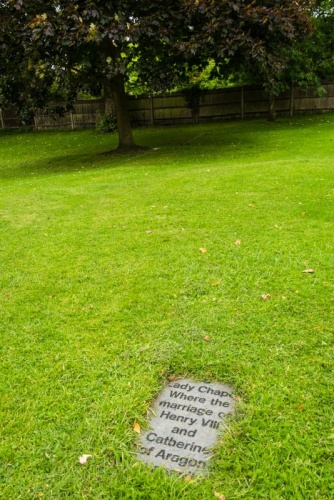
Inside the church, the highlight is the beautifully intricate 14th-century screen, with 5 open bays. The roof looks original, but it is actually a sympathetic restoration of the Perpendicular original, dating to 1871.
There are quite a few funerary monuments and floor brasses, but the stained glass window depicting Henry I is a modern creation.
The Henry VIII Connection
The Lady Chapel at Dunstable Priory was the site of a pivotal moment in Tudor history. It was here that Archbishop Cranmer made the pronouncement officially annulling Henry VIII's marriage to Katherine of Aragon. The proclamation was a turning point in the English Reformation and was an essential step in the creation of the Anglican Church.
The chapel was pulled down after the Priory was dissolved by Henry VIII. The site of the Lady Chapel is marked by a plaque on the grassy area east of the current Priory building. The outline of the chapel itself is marked by white paint on the grass.
The Priory was dissolved by Henry VIII in January 1540. The Prior and the 12 remaining canons were granted pensions. Plans were mooted to convert the medieval Priory to a new cathedral, but the plans came to nothing and the remaining medieval buildings were pulled down.
The Ancient Bell
On the south aisle wall is a 14th-century bell, given to the Priory during the Black Death of 1349. According to the Priory annals, the parishioners had a bell cast and called it 'Mary'. The bell was probably cast by John Rufford of Toddington. It served as a sanctus bell and was inscribed 'Ave Maria Gratia Plena', or 'Hail Mary Full of Grace'. This suggests that it was used to ring the Angelus. After the Dissolution of the Monasteries, the bell was hung at the old Town Hall and served as a fire bell.
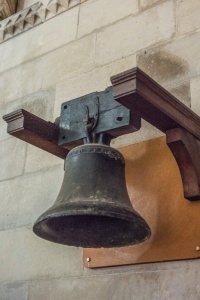
Medieval Brasses
Also on the south wall is an exceptional collection of medieval brasses. The oldest brass is that of Laurence Pygot, a wool merchant, who died in 1450. It shows Pygot with his wife Alice and smaller figures of their 3 sons and 6 daughters. At the corners are four shields, bearing Pygot's wool-merchants mark.
Nearby is another 15th century brass to a wife of John Peddar. Another brass shows Henry Fayrey and his wife Agnes. The brass shows Henry and Agnes in their shrouds, with a caption that reads, ‘Off yo charite py for the soule of Henry Fayrey and Agnes his wife, the which lyeth buried under this stone and the said Henry decessid the XXVIII dai of December AD MCCCCCXVI’.
Of the later memorials, the one that really caught my eye was the monument to Thomas Chew Cart of the Inner Temple in London, who died in 1722 at the age of 23. The monument was erected 'at the Charge of his Pious mother'.
Beside it is a small plaque to Mrs Jane Cart, who died in 1736 and was buried at the church of St Mary le Bow in London. She was the wife of James Cart, a London merchant. The epitaph is a wonderful example of 18th-century sentiment.
It reads in part, 'She was eminently pious, and extensively charitable. A set of plate for the Holy Communion and sundry other elegant decorations given to this church; the Lord's Day afternoon lecture here instituted, and the bread of her donation weekly distributed to the poor; the charity school in this town founded and endowed, to which she contributed a third part; and six alms houses for aged women by her solely erected ....'
The old west doors still show the marks of shots fired during the English Civil War. In June 1944 Royalist soldiers attacked the Priory and you can clearly see holes where their musket balls lodged in the oak door.
Dunstable Priory is one of the finest examples of medieval architecture in southern England. The west front is sublime, and the history of the Priory is very well explained through a series of information panels around the site. There is a paid parking area directly in front of the church, off High Street.
Related:
Dunstable
About Dunstable Priory
Address: Church Street,
Dunstable,
Bedfordshire,
England, LU5 4HN
Attraction Type: Historic Church
Website: Dunstable Priory
Location
map
OS: TL021218
Photo Credit: David Ross and Britain Express
HERITAGE
 We've 'tagged' this attraction information to help you find related historic attractions and learn more about major time periods mentioned.
We've 'tagged' this attraction information to help you find related historic attractions and learn more about major time periods mentioned.
Find other attractions tagged with:
Augustinian (Historical Reference) - Henry I (Person) - Henry VIII (Person) - Norman (Architecture) -
NEARBY HISTORIC ATTRACTIONS
Heritage Rated from 1- 5 (low to exceptional) on historic interest
Dunstable Downs and Whipsnade Estate - 1.2 miles (Countryside) ![]()
Whipsnade Tree Cathedral - 2.5 miles (Cathedral) ![]()
Whipsnade Zoo - 2.7 miles (Family Attraction) ![]()
Eaton Bray, St Mary the Virgin Church - 3.1 miles (Historic Church) ![]()
Chalgrave Castle - 3.5 miles (Castle) ![]()
Edlesborough, St Mary's Church - 3.6 miles (Historic Church) ![]()
Chalgrave, All Saints Church - 3.6 miles (Historic Church) ![]()
Stockwood Discovery Centre - 4.2 miles (Museum) ![]()
Nearest Holiday Cottages to Dunstable Priory:
Bletchley, Buckinghamshire
Sleeps: 6
Stay from: £861 - 2487
More self catering near Dunstable Priory

